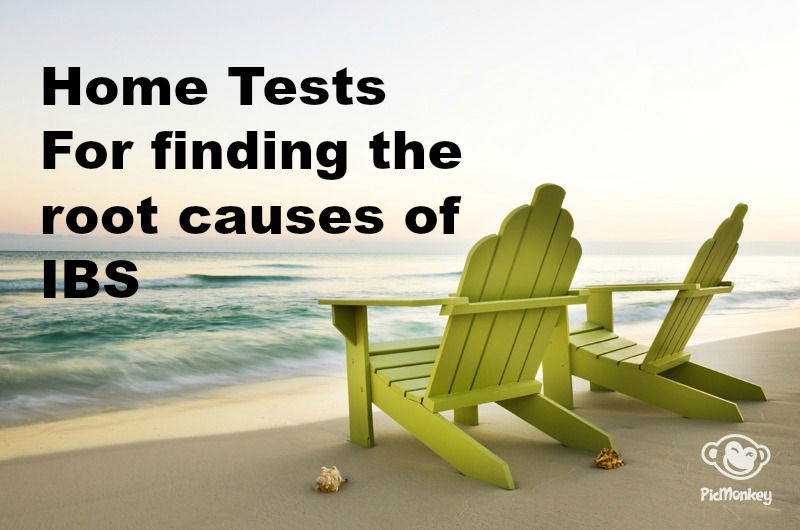We all do it.
When mysterious health symptom hit we jump online and start googling our symptoms. The Internet has been a blessing for health education and empowerment.
But it can also be trouble.
I’ve heard it referred to as the “Google Death Spiral“.
You begin by googling a symptom and end up thinking you’ve got one or more terminal diseases.
Information is power, it’s just that today there’s too much of it. And some of it is wrong. Worse than wrong, it can do damage. Googling digestive symptoms can be fuel for growing fear and neurosis. Especially when we’re inclined to expect the worst.
Years ago, Google lead me astray. To battle IBS, I became a raw foodist for almost a year. I bought into the acid alkaline theory, the detoxification theory and increased enzymes theory of raw food.
My brain latched onto this diet and it’s promising theories and stuck to it despite the fact that it made me feel worse.
For example, I was allergic to nuts at the time and the raw diet gets all it’s protein from nuts. It got to the point of intestinal bleeding but even that didn’t stop me.
I know better now and I teach IBS people not to eat raw veggies. And I also challenge them to not believe what they read without truly testing it out first.
I notice that many people like to diagnose themselves based on symptoms they read online. Not a good strategy.
The golden rule is to test not guess.
I follow the functional medicine model. Before treating symptoms with random diets and supplements, no matter how highly recommended online, you need to get down to the root cause of the issue.
Going low FODMAP if you don’t have bacterial overgrowth or carb intolerance doesn’t make sense? Fasting and cleansing is a bad idea if you your adrenals are stressed and fatigued.
The golden rule in healing mysterious health conditions is to test. I’ve written about functional lab testing here. These tests aren’t cheap and most people struggle with faith in spending money on something that may show nothing, like all the other tests they’ve taken.
In my opinion, the lactulose-based SIBO test is definitely worth taking to rule this issue out. This is test can be done at home and is the cheapest of the tests at $150. SIBO is extremely prevalent right now. It’s primary symptom is bloating and it can’t be healed with diet or stress reduction. It takes a very specific protocol to treat.
I present to you some other tests you can take that are low cost or free and can be done in your home also. These tests can help you dig deeper into your root cause of IBS. It’s much better approach than emotionally diagnosing yourself based on what you read online. They will give you something more concrete to work with.
Another bonus is that these tests don’t require you to drool in a tube, play with your poop or drink anything weird, like the functional lab test do.
The root causes these tests look into are low stomach acid, yeast overgrowth (candida), bacterial overgrowth or imbalance, or food allergies.
If you tests positive, you can confirm your findings with lab work.
Home test #1: Candida
Candida is a yeast that naturally resides in your body. It’s only harmful when it overgrows. The biggest reason for overgrowth is antibiotics, steroids or the birth control pills. Also, a high carb, high sugar, processed diet, and alcohol encourages overgrowth, especially when coupled with stress.
A candida overgrowth can cause the symptoms associated with IBS and more. While the home test is not as reliable as a stool test it can give you a good idea of what’s going on.
For six days, when you wake up, before eating or drinking, fill a glass of water halfway and spit a dime-sized amount of saliva into it.
Watch it a few times over a 45-minute period and record your results every day. Do this six days.
Your saliva will either float on top or sink to the bottom or grow legs. If it stays floating, there’s likely no Candida overgrowth, but if it grows legs or sinks, then Candida is likely an issue for you.
Home test #2: Bacterial balance
The most promising research in digestive health is the human biome. The biome is the name for the bacterial ecosystem that live within our body. We used to think that bacteria was all bad and caused disease, but are finding that a balance of good guys and bad guys make up a healthy ecosystem. If your bacterial ecosystem is in balance you tend to feel great, digest well and become on of those happy people everyone envies.
Your friendly bacteria are your internal police force. They keep everything in balance and make sure yeasts like candida don’t overgrow. They also work with your immune system to help kill invading pathogens like viruses, pathogenic bacteria and parasites.
Probiotics are extremely popular these days. But do they help? And what’s the best brand? Of course it depends on what’s going on with your body and if the probiotics in your supplement are still alive. There’s a way you can check.
The best and cheapest home tests to map your own biome is Ubiome. A single test costs $89 and a time lapse kit costs $199. The time lapse kits is one of the most powerful home tests there is because it allows you to see if your diet and the probiotics are actually working to rebalance and diversify your bacterial ecosystem.
The ubiome results will tell you how diverse your biome is and what species dominate. It is best to have a higher percentage of Bacteroidetes than Firmicutes .
The test is easy to take, all you have to do is wipe a q tip on the toilet paper you used to wipe yourself.
If you are afraid that you won’t be able to read and understand your ubiome results I offer a low cost 45 minute discovery session to go over your results and come up with dietary and probiotics adjustments to shift your balance. To get more info click here.
If you are interested in trying the Ubiome test you can get 15% off of your test kits here.
Test #3: Food Allergies.
This test takes a patience and care but it’s fairly accurate for food allergies or sensitivities. It can catch things that lab test don’t. It’s called the Cocoa Pulse Test.
It involves checking your pulse then putting a certain food in your mouth for 30 seconds (without chewing) and then checking your pulse again. If your pulse rises 6 points it indicates a problem with that food. If it doesn’t the food is likely safe.
Here’s a link to all the specific details on how to do that test.
Home test #4 Low stomach acid
Low stomach acid is actually more common than high stomach acid. Stomach acid is one of our greatest defenses against the pathogens we ingest. Stomach acid is also extremely important for nutrient absorption, breaking down protein and activating important enzymes. Low stomach acid can be a cause of digestive issues.
There’s an expensive lab test called ‘The Heidelberg Stomach Acid Test’ that gives you precise data about your stomach acid levels. Before shelling out the cash for this test there are two home options to try first.
The first is drinking 1/4 teaspoon of baking soda in 4 to 6 ounces of cold water first thing in the morning. If it takes you 3 minutes or longer to burp that can be an indication of low acid.
Another test is using HCL (hydrochloric acid) supplements. The HCL test is best done under the guidance of an experienced practitioner in case you have issues with stomach inflammation or are taking contraindicated medication like NSAIDS and corticosteroids.
Here are the instructions on how to do it .
I think it’s best to start out with a teaspoon of apple cider vinegar, Swedish bitters, or lemon juice before your meals to see if it helps with digestion. You can increase that dose to a tablespoon if it seems to help. This is an indication that your stomach acid levels are lower than optimal. Supplementing with HCL may be required, but should be done with an experienced practitioner.
So here are a few ways you can start taking your health in your hands. Feel free to contact me if you have any questions about these tests.


